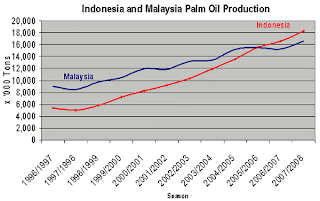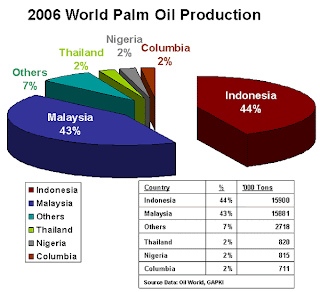A significant change in the
oil palm industry has taken place during the past season, as Indonesia surpassed Malaysia in production of palm oil and is now the world leader. This designation will continue and Indonesia’s production rate will outpace Malaysia for the foreseeable future. Personnel from the USDA
Foreign Agricultural Service (
FAS) conducted crop-assessment travel in the main
palm oil production regions of Sumatra and West Kalimantan during August and September. The team met with
palm oil estate managers, agricultural officials, researchers, and independent commodity analysts. The
plantation visits were targeted in the country’s most important producing provinces. Regular surveys of fruit bunches three months prior to harvest were indicative of an output surge in fresh fruit bunches. Assuming normal rainfall and based on bunch counts there will be a surge in production during the last quarter of 2007 and into early 2008. In contrast, drier than normal conditions at the beginning of the year marginally reduced output for about three months. Oil production for all major producing areas is favorable despite some dryness in early 2007. Indonesia is forecast to produce 18.3 million metric tons of
palm oil in 2007/08.
 Palm oil
Palm oil comes from the fruit of the oil palm tree, a tropical species that originated in West Africa, but now grows as a hybrid in many parts of the world, including SE Asia and Central America. The relatively low priced oil is used for a variety of purposes. The world demand for palm oil has soared in the last two decades, first for its use in food, consumer products and more recently as the raw material forf biofuel. The growing affluence of India and China, the worlds top two importing nations, will increase demand of edible vegetable oils. In the US, a recent wave of dietary focus on the trans-fat issues has led to increased consumption. In addition to being less expensive, palm oil is semi-solid at room temperature, making it ideal for baking and food production. Many food manufacturers are trying to find alternatives to trans-fat, partially hydrogenated oils, which contribute to heart disease and other medical problems. Although, palm oil is not without its own contribution to heart disease, the focus on the transfat issue has resulted in palm oil being considered more healthful than some other fats. The other major factor of palm production is its role in sustainable energy campaigns around the globe. European countries have promoted the use of
palm oil by injecting hundreds of millions of dollars into national subsidies towards bio-diesel. Europe is now a leading importer of palm oil. Through the subsidizing of biofuels, European governments have accelerated the demand for palm oil in Europe, and as a consequence have accelerated the conversion of large areas of rainforest in South East Asia. Palm oil plantations are often expanded by clearing existing forest land and draining peat swamps. Many economists predict it will be the leading internationally traded edible oil by the year 2012.
Today, Malaysia and Indonesia account for about 87 percent of world production

Artikel keren lainnya:
Belum ada tanggapan untuk "Palm Oil Production Prospects Continue to Grow"
Post a Comment
Kritik dan Saran yang membangun dari Anda sangat KAMI harapkan.
Silahkan isi KOMENTAR anda yang membangun untuk kemajuan dan koreksi di blog ini.No Sara, No Racism